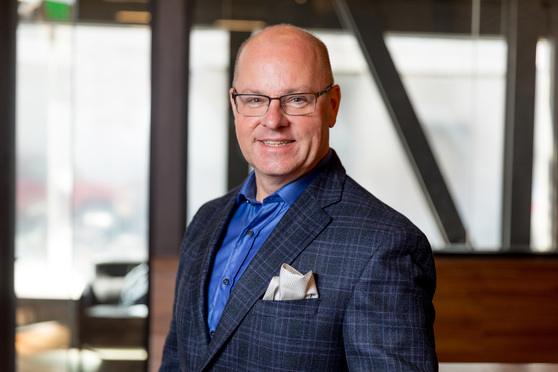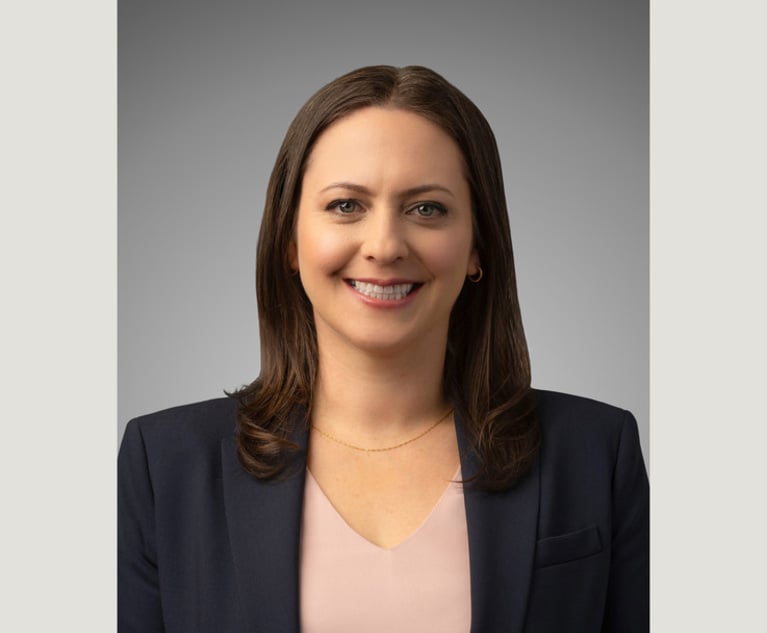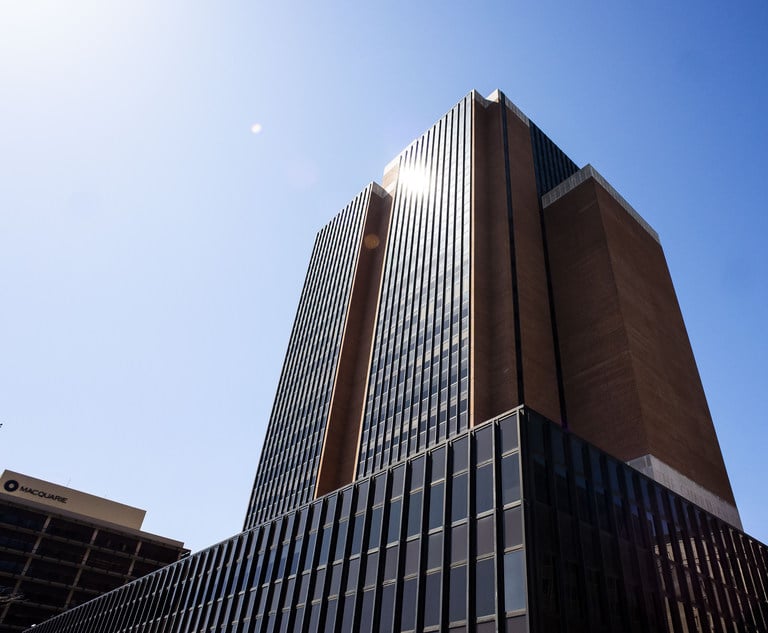IP at the Supreme Court: A Quiet—but Possibly Busy—Year
Teasing out the America Invents Act continues to be a focus. But don't be surprised if trademark and copyright figure prominently in the mix.
September 26, 2018 at 09:21 PM
12 minute read
 Mark Lemley. (Photo: Jason Doiy/ALM)
Mark Lemley. (Photo: Jason Doiy/ALM)With only two cases on the docket so far and a few high-profile cases more than a year away, Term 2018 is shaping up to be a sleepy one for intellectual property at the Supreme Court.
“I think relative to previous years it's a pretty quiet year, said Mark Lemley professor at Stanford Law School. Lemley joins others in looking ahead to battles over sovereign immunity in administrative patent proceedings, as well as a copyright battle between Oracle and Google. But those cases aren't likely to land at the court's conference till next year, meaning that any hearing would likely get pushed to Term 2019.
As for this year, “There really isn't anything that seems squarely teed up, at least not in patents,” Emory law professor Timothy Holbrook says.
Yet some IP practitioners think an interesting year could be ahead. With the Supreme Court in a year of transition following Anthony Kennedy's retirement, Gibson Dunn & Crutcher partner Allyson Ho expects the justices to be on the lookout for important cases where they can generally count on broad agreement. That, she said, often means IP.
“On the heels of great change on the court, it would not be surprising to me if several more [IP cases] were added,” she noted. Ho added that a dispute over inequitable conduct and a case seeking to flesh out 2016's Halo v. Pulse decision on willful infringement have a plausible chance of getting cert.
The Supreme Court is expected to announce Thursday which cases it's taking from its long conference of petitions filed over the last several months. Other cases before the court ask whether district judges, rather than juries, should decide whether a patent is invalid for obviousness and whether patents that predate the America Invents Act are immune from AIA challenges at the Patent Office.
On Friday, Hewlett-Packard is expected to petition for cert in one of the biggest Federal Circuit decisions of the year: Berkheimer v. HP, which made it more difficult bring Section 101 eligibility challenges early in litigation. That case figures to land on the court's conference later this fall.
If none of those patent cases catch the court's attention, the justices could look to trademark and copyright issues. The court's already taken up one such case, on the timing for copyright registrations. On the trademark side, the Patent Office is appealing a Federal Circuit ruling that extended the Supreme Court's 2016 Lee v. Tam ruling to “scandalous” marks that employ obscene words or images. Ho thinks the court might take a look at an Eleventh Circuit decision that reluctantly held a service mark can extend to goods.
“It's now a given that the court is going to have a much steadier diet of intellectual property cases than it historically had,” Ho said. Even if 2018 turns out to be a down year, “I think it's going to be a regular part of the court's docket” going forward.
The Supreme Court granted certiorari in one patent case last summer. Arguments are due around the first of the year in Helsinn Healthcare v. Teva Pharmaceuticals USA. The issue there is whether a European pharma's private supply agreement with a U.S. distributor triggered patent law's on-sale bar, which forbids patenting inventions already in public use.
Helsinn argues that the America Invents Act narrowed the reach of the on-sale bar by limiting it to inventions “in public use, on sale, or otherwise available to the public before the effective filing date of the claimed invention.” The “otherwise” language makes clear that, “under the AIA, a sale must make a claimed invention available to the public in order to trigger the on-sale bar,” Helsinn's lawyers at Williams & Connolly and Paul Hastings argue.
Teva says the AIA did not modify the on-sale bar and that the supply agreement was made public in an SEC filing. The solicitor general's office is supporting Helsinn.
Lemley said the issue touches on an increasingly challenging area of patent law, which is what exactly constitutes public prior art. Historically, if something appeared in a book or a product, that was a simple question to answer. “We didn't have a category for 'we tweeted about it' or 'I had a poster presentation at a scientific conference at which people could see my PowerPoint presentation but not get a copy of them,'” Lemley said.
But to rule for Helsinn, Lemley and Holbrook argue, the court would have to overrule numerous precedents that have guided those kinds of decisions for more than a century. The court would have to be “willing to mess with a lot of patent law in order to say, 'As long as I declare my sale confidential, it's not prior art anymore,'” Lemley said.
Kirkland & Ellis IP partner John O'Quinn said Helsinn is “another example of the court taking cases to tease out the America Invents Act,” a pattern he expects to continue.
The other case already pending before the court is Fourth Estate Public Benefit v. Wall-Street.com. The case will decide when a copyright registration becomes effective—when the application and fee have been deposited with the Copyright Office or when the office subsequently acts on the application. The regional circuits have been split on the issue; a ruling for Wall-Street.com would mean that copyright holders have to wait an additional eight months on average for their registrations, according to the solicitor general. Registration is a prerequisite to suing for copyright infringement.
“There are some things that are more important that they be decided than they be decided correctly,” Lemley quipped. “Getting this resolved will be useful, but I expect this to be a short unanimous opinion that no one pays much attention to thereafter.”
So what else could be in the pipeline?
One possibility is the question left dangling in last year's biggest patent case: the Oil States constitutional challenge to the Patent Trial and Appeal Board (PTAB). Justice Clarence Thomas' majority opinion upheld the constitutionality of the inter partes review mechanism for challenging patent validity. But he explicitly stated that the court was not deciding whether other plaintiffs who obtained their patents before the America Invents Act could bring a similar challenge.
Opinions are split as to what the court meant. “I think what they were trying to do, which they've done in lots of cases relatively recently, is try to be as narrow as possible in their rulings,” Lemley said. Patent holders might try to bring retroactivity challenges. “I just don't think they're going to go anywhere,” Lemley said.
Holbrook has a different take. “I do think that they'll take a retroactivity case because they signaled it so much,” he said. “You don't make that statement unless you think it actually needs to be addressed.”
Stambler v. MasterCard Inc. is one case presenting that issue. Patent owner Leon Stambler “invested time and money to obtain a patent, with the expectation that his patent rights could only be taken following a jury trial in an Article III forum,” Edward Nelson of Nelson Bumgardner writes in support of his cert petition. “Then Congress changed the rules, depriving Mr. Stambler of the judicial protection he had when the patent was issued.”
Another PTAB-related issue before the court is the right of third parties to appeal following AIA proceedings. The AIA permits anyone to challenge patent validity at the PTAB, but the Federal Circuit has said third parties lack constitutional standing to appeal. RPX Corp. and Daniel Ravicher of the Ravicher Law Firm are asking the Supreme Court to take a look in RPX v. ChanBond.
”It's an interesting question,” Lemley said, and its constitutional nature could make it more attractive than the ordinary IP case.
Lemley, who practices at Durie Tangri, is petitioning himself in Nichia v. Everlight Electronics, arguing that obviousness is a question of law that should be decided by judges, not juries. “This court has consistently held over the past two centuries that whether an invention is obvious is a question of law,” he writes.
Ho sees two other possibilities. In one, Regeneron Pharmaceuticals is challenging an inequitable finding that was the result of an adverse inference based on litigation misconduct. In the other, Bombardier Recreational Products Inc. argues that a finding of willful infringement and enhanced damages requires knowing and intentional conduct, not mere negligence.
“I think the court continues to be interested in the intersection of patent law and more bread-and-butter, garden variety procedural issues,” Ho said, and those two cases fit that bill.
Then there's Berkheimer, the Section 101 case. Judge Alan Lourie wrote in a dissent from denial of en banc review that the law of Section 101 needs clarification “by a higher authority, perhaps by Congress.”
Despite that request, Holbrook doesn't expect Supreme Court intervention. “I would be stunned if they took another 101 case,” he said. “I think from their viewpoint, 'We've given you law of nature, we've given you abstract idea, we're done. Sort it out yourself.'”
Two trademark cases stand out from the pack. Last year the Supreme Court struck down on First Amendment grounds a Lanham Act provision that prohibited marks which “disparage” individuals or groups of people. The Federal Circuit followed up by extending that reasoning to a related provision that bars “scandalous” marks.
The government, which is trying to block Erik Brunetti from registering his FUCT merchandise brand, petitioned for cert earlier this month. “Under the proper analysis, the First Amendment does not prohibit Congress from making vulgar terms and graphic sexual images ineligible for federal trademark registration,” the Justice Department argues in its cert petition.
Meanwhile, Sportswear Inc. is challenging an Eleventh Circuit decision that blocks it from marketing apparel that uses the Savannah College of Art and Design mark. Sportswear argues that Savannah College registered the mark only for use in educational services. But the Eleventh Circuit held that it was bound by a 1975 Fifth Circuit opinion, Boston Professional Hockey v. Dallas Cap & Emblem, that extended service mark protection to goods. “Although Boston Hockey does not explain how or why” the protection should be extended, “it constitutes binding precedent that we are bound to follow,” the Eleventh Circuit held.
In the copyright arena, a Second Circuit fair use decision that made headlines earlier this year has landed at the court. Petitioner TVEyes is a company that records more than 1,400 channels around the clock, then uses closed captioning and speech-to-text software to make all of it searchable by the words spoken in video. Journalists, marketers, law enforcement and even the White House pay $500 a month for access to the index. Once a subscriber finds content it wants to view, TVEyes provides a 10-minute clip, which can be shared with nonsubscribers. The Second Circuit agreed with copyright holder Fox New Networks that that stretches fair use too far.
Lemley said he thinks the Second Circuit decision was unfortunate. While the high court could take it up to examine the issue of transformativeness in fair use, he said the odds are probably against it. Oracle v. Google, another fair use case expected to land at the court toward the end of the year, looks like a better bet, he said.
Jason Bloom, the head of Haynes and Boone's copyright practice group, said there's a reason the Supreme Court hasn't taken up a fair use case in more than 20 years—it's set out in detail in the Copyright Act. “I don't know if there's much the Supreme Court can do,” he said. “Given what the test is, nothing the Supreme Court says is going to clarify it.”
Bloom said he thinks TVEyes is distinguishable from the Second Circuit's Google Books decision, because Google took pains to ensure that entire works could not be pieced together from Google Books snippets.
Lemley, Holbrook, Ho and O'Quinn all think the issue of sovereign immunity at the Patent Trial and Appeal Board is a very likely bet for Supreme Court review. Allergan Inc. has tried to shield its patents from PTAB review by licensing them to the St. Regis Mohawk Tribe, which then asserted its tribal immunity. The Federal Circuit agreed with Mylan Pharmaceuticals Inc. and other challengers that tribal immunity does not extend to administrative actions before the PTAB.
Even if tribal sovereign immunity is a good idea, generally, “it seems it's a bad idea to apply it to patent owners who are trying to take advantage of the court system and use it as both a shield and a sword,” Lemley said.
“That's the only [patent case] that I really see in the pipeline that just seems to scream, 'Yes, Supreme Court, review this,'” Holbrook said.
The big questions are timing and vehicle. Allergan and St. Regis are trying to persuade the Federal Circuit to review the case en banc. In the meantime, a dispute over the University of Minnesota's invocation of state sovereign immunity in the PTAB is likely to be argued before the Federal Circuit early next year.
O'Quinn expects either or both cases to wind up at the Supreme Court. “I will be very surprised if this decade were to end,” he said, without the court having its say on sovereign immunity at the PTAB.
This content has been archived. It is available through our partners, LexisNexis® and Bloomberg Law.
To view this content, please continue to their sites.
Not a Lexis Subscriber?
Subscribe Now
Not a Bloomberg Law Subscriber?
Subscribe Now
NOT FOR REPRINT
© 2025 ALM Global, LLC, All Rights Reserved. Request academic re-use from www.copyright.com. All other uses, submit a request to [email protected]. For more information visit Asset & Logo Licensing.
You Might Like
View All
Weil Lures DOJ Antitrust Lawyer, As Government Lateral Moves Pick Up Before Inauguration Day
5 minute read
Supreme Court Wrestles With Disabled Ex-Firefighter's Discrimination Case

SEC Ordered to Explain ‘How and When the Federal Securities Laws Apply to Digital Assets’
5 minute read
Kirkland, Cleary, King & Spalding Among the Latest to Add DC Laterals
3 minute readTrending Stories
- 1Snapshot Judgement: The Case Against Illustrated Indictments
- 2Texas Supreme Court Grapples Over Fifth Circuit Question on State Usury Law
- 3Exploring the Opportunities and Risks for Generative AI and Corporate Databases: An Introduction
- 4Farella Elevates First Female Firmwide Managing Partners
- 5Family Court 2024 Roundup: Part I
Who Got The Work
J. Brugh Lower of Gibbons has entered an appearance for industrial equipment supplier Devco Corporation in a pending trademark infringement lawsuit. The suit, accusing the defendant of selling knock-off Graco products, was filed Dec. 18 in New Jersey District Court by Rivkin Radler on behalf of Graco Inc. and Graco Minnesota. The case, assigned to U.S. District Judge Zahid N. Quraishi, is 3:24-cv-11294, Graco Inc. et al v. Devco Corporation.
Who Got The Work
Rebecca Maller-Stein and Kent A. Yalowitz of Arnold & Porter Kaye Scholer have entered their appearances for Hanaco Venture Capital and its executives, Lior Prosor and David Frankel, in a pending securities lawsuit. The action, filed on Dec. 24 in New York Southern District Court by Zell, Aron & Co. on behalf of Goldeneye Advisors, accuses the defendants of negligently and fraudulently managing the plaintiff's $1 million investment. The case, assigned to U.S. District Judge Vernon S. Broderick, is 1:24-cv-09918, Goldeneye Advisors, LLC v. Hanaco Venture Capital, Ltd. et al.
Who Got The Work
Attorneys from A&O Shearman has stepped in as defense counsel for Toronto-Dominion Bank and other defendants in a pending securities class action. The suit, filed Dec. 11 in New York Southern District Court by Bleichmar Fonti & Auld, accuses the defendants of concealing the bank's 'pervasive' deficiencies in regards to its compliance with the Bank Secrecy Act and the quality of its anti-money laundering controls. The case, assigned to U.S. District Judge Arun Subramanian, is 1:24-cv-09445, Gonzalez v. The Toronto-Dominion Bank et al.
Who Got The Work
Crown Castle International, a Pennsylvania company providing shared communications infrastructure, has turned to Luke D. Wolf of Gordon Rees Scully Mansukhani to fend off a pending breach-of-contract lawsuit. The court action, filed Nov. 25 in Michigan Eastern District Court by Hooper Hathaway PC on behalf of The Town Residences LLC, accuses Crown Castle of failing to transfer approximately $30,000 in utility payments from T-Mobile in breach of a roof-top lease and assignment agreement. The case, assigned to U.S. District Judge Susan K. Declercq, is 2:24-cv-13131, The Town Residences LLC v. T-Mobile US, Inc. et al.
Who Got The Work
Wilfred P. Coronato and Daniel M. Schwartz of McCarter & English have stepped in as defense counsel to Electrolux Home Products Inc. in a pending product liability lawsuit. The court action, filed Nov. 26 in New York Eastern District Court by Poulos Lopiccolo PC and Nagel Rice LLP on behalf of David Stern, alleges that the defendant's refrigerators’ drawers and shelving repeatedly break and fall apart within months after purchase. The case, assigned to U.S. District Judge Joan M. Azrack, is 2:24-cv-08204, Stern v. Electrolux Home Products, Inc.
Featured Firms
Law Offices of Gary Martin Hays & Associates, P.C.
(470) 294-1674
Law Offices of Mark E. Salomone
(857) 444-6468
Smith & Hassler
(713) 739-1250










